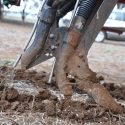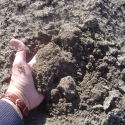07 Mar 2016
Chelmsford P and K response 2014-2015
Deep banded P and K over two crops
 Chelmsford wheat and deep K
Chelmsford wheat and deep K
Research in Central Queensland has shown long term responses to deep placed P and K in cropping system. In 2014 a site was selected at Chelmsford (40 km north of Kingaroy, Queensland) to assess the response to deep placed P and K on these soils. The soil type is a vertosol and Table 1 below shows the soil test results for the site. Topsoil and subsoil P values are low, with a soil test critical range (90% relative yield) reported as 12-19 mg/kg. The critical soil test K for high CEC soils are not clearly described as soil moisture and crop rooting patterns seem to be important, with roots able to access soil K more efficiently in moist soils that dry soils. An indicative value of 0.40 cmol/kg has been proposed, which is equivalent to a Colwell K soil test of 150 mg/kg. So, the site would be expected to respond to both K and P.
Table 1 Pre-sowing soil test values for the Chelmsford site, 2014.
| Depth | Colwell P (mg/kg) | BSES-P (mg/kg) | Ex-K (cmol/kg) | ECEC (cmol(+)/kg) |
| 0-10 cm | 16 | 12 | 0.21 | 41 |
| 10-30 cm | 2 | 4 | 0.14 | 43 |
| 30-60 cm | <2 | 3 | 0.12 | 45 |
Phosphorus and Potassium were deep placed (~20 cm) prior to seeding at rates to supply 0 or 40 kg/ha P (as triple superphosphate) and 0, 25, 50 or 100 kg/ha K (as muriate of potash). Rows were spaced 50 cm apart. The wheat crop was sown in mid-May into good stored soil moisture. There was no more rainfall until mid-grain fill, when 20 mm fell. Even though dry winters are common in the sub-tropical cropping regions, this season was particularly dry. Grain yields and nutrient concentration in the biomass (Table 2) are shown below.
Table 2, The response of wheat and sorghum to different rates of deep placed P and K at Chelmsford, Queensland, 2014 and 2015.
Wheat | Sorghum | ||||
K | P | Grain yield (t/ha) | Biomass P kg/ha | Biomass K kg/ha | Grain Yield (t/ha) |
0 | 0 | 3.84 | 13.8 | 71.0 | 5.08 a |
100 | 0 | 4.12 | 16.6 | 96.0 | 5.77 d |
0 | 40 | 4.33 | 16.3 | 77.7 | 4.91 ab |
25 | 40 | 4.39 | - | - | 5.32 cd |
50 | 40 | 4.54 | - | - | 5.56 d |
100 | 40 | 4.48 | 15.0 | 90.0 | 5.72 d |
LSD (p<0.05) | 0.26 | 2.0 | 11.6 | ||
Grain yield increased with added K in the absence of P, but when P was supplied, yields were increased but the response to K was smaller than when P was absent. Similar to other experiments in this region, the combined response to P and K provided the highest grain yield.
The site was sown to Sorghum in January 2015 and harvested in April to assess the residual value of the applied nutrients (Table 2). No additional P or K was supplied. Figure 1 shows the cumulative response to deep K over the two crops compared to the nil fertilizer control. K alone showed an 11% yield response, with the response in sorghum making up a larger proportion of the total response than wheat.
Figure 1. Cumulative response of wheat and sorghum to deep placed K and P at Chelmsford.
Conclusions
- · The response to deep place nutrients shows residual values, in this case, into the second crop.
· The response to K alone was significant, as would be expected given the soil test values.
· There were a larger response to K was seen in the wheat crop when both P and K were present.
· For more information, see http://anz.ipni.net/topic/managing-k-in-northern-cropping-systems




